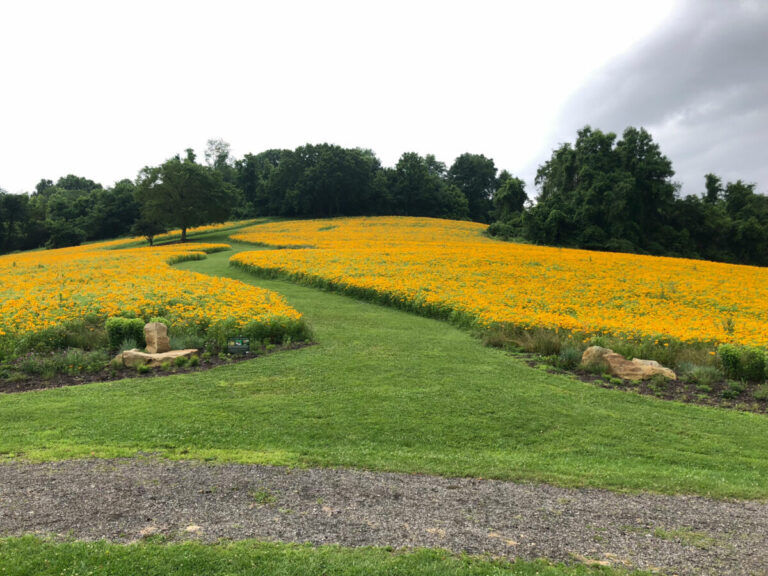Across the United States, millions of acres are locked in a cycle of over-mowing. Turfgrass may look neat, but it offers little to pollinators, birds, or the soil beneath our feet. Fortunately, a growing number of parks and land managers are proving there’s a better way: converting turf into thriving wildflower meadows.
In this blog, we’ll look at how Allegheny County’s Boyce Park transformed an over-mowed hillside into a vibrant, pollinator-friendly meadow, and what lessons others can take from its success, including:
- The story of how Boyce Park’s wildflower meadows came to life
- The ecological benefits of turf-to-meadow conversions
- Practical advice for planning and managing meadow projects
- Recommended native species that provide food and shelter for pollinators
Let’s begin by looking at Boyce Park before its transformation.

z
The Allegheny County Parks Foundation oversees more than 12,000 acres of public land in the Pittsburgh metro area, welcoming millions of visitors each year. When the foundation conducted an ecological assessment in 2015, one site stood out: Boyce Park, a sprawling 1,100-acre landscape east of the city. The survey revealed that vast stretches of the park were dominated by turfgrass, mowed regularly for decades, but offering little ecological value.
The Ecological Drawbacks of Turfgrass
Unlike native wildflower meadows, turfgrass is essentially a monoculture. It requires constant mowing and provides no nectar for pollinators, no seed for birds, and minimal cover for wildlife. Large expanses of turf also allow rainwater to run off rather than soak into the ground, carrying pollutants into streams and eroding soil. For park systems, this makes turf both ecologically poor and costly to maintain.
By contrast, converting even a portion of those acres into wildflower meadow reduces mowing needs while dramatically boosting biodiversity.
As Joel Perkovich, Landscape Architect with the Allegheny County Parks Foundation, explained, “The purpose of [our ecological assessment] was to inventory the quality of the existing ecosystems within the park. Things like the quality of forest communities, opportunities to improve stormwater quality, and essentially taking an inventory of the existing ecological quality of the park. And then, opportunities to improve them.”
The heavily managed grasslands, he noted, were prime candidates for something better: “We found areas that had been mowed for 50, 60 years, and you just have turf grass everywhere. Those tend to respond really well to being converted to meadow.”

Building the Wildflower Meadow with Ernst Seeds
Once Boyce Park’s ecological assessment was complete, the Parks Foundation identified an eight-acre hillside of turfgrass as the best candidate for restoration. The area had been mowed for decades, which ironically worked in their favor. Regular mowing had prevented invasive weeds from taking hold, leaving behind a relatively clean soil bed ideal for seeding.
Teaming up with Ernst for the projects was a relatively easy decision for Perkovich, as he has had success with Ernst Conservation Seeds seed mixes in the past. “Ernst has a very good reputation as a supplier of native seed mixes,” said Perkovich. “They’re well-established, they have a great reputation, and also a reliable product.”
With approval secured, the team chose the Showy Northeast Native Wildflower & Grass Mix, a blend of species tailored for the region.
How the Seeds of Change Led to Growing Success
The results were immediate. “The first growing season, there was a stunning sight of wildflower blooms,” recalled Perkovich. “Prior to that, it was just really a large, mowed hillside surrounded by woodlands.”The project’s success didn’t stop there. Over the next several years, the county expanded its efforts, establishing more than 40 acres of wildflower meadows across six park sites. At Boyce Park specifically, restoration efforts grew to include a rain garden and a 9,500-square-foot wildflower planting at the Four Seasons Lodge, designed to reduce stormwater runoff, filter pollutants, and provide more habitat for pollinators. What began as a single meadow quickly became a blueprint for ecological restoration across Allegheny County’s park system.

The Ecological Payoff
The transformation at Boyce Park fundamentally reshaped the park’s ecological value. As Perkovich put it, “It is visually indisputable. The amount of diversity of life that utilizes those better habitats, compared to what previously existed there, is incredible.”
Pollinator Gains
- Bees & Butterflies: Wildflower meadows supplied nectar and pollen sources absent in turfgrass, drawing native bees, monarchs, and swallowtails.
- Hummingbirds: Late-summer blooms like blazing star create reliable food sources.
Bird & Wildlife Habitat
- Nesting cover: Native grasses such as little bluestem and Virginia wildrye provided structure for ground-nesting birds.
- Winter food: Seedheads from coneflowers and goldenrods sustained finches and sparrows.
- Insect abundance: A diverse mix of blooms supported insects that in turn fed warblers, flycatchers, and other songbirds.
Ecosystem Services
- Stormwater control: Deep-rooted perennials improved infiltration, reducing erosion and filtering pollutants.
- Soil enrichment: Decaying roots built organic matter, enhancing long-term soil health.
- Carbon storage & reduced emissions: Fewer mowing cycles cut fuel use and air pollution.
Human Impact
The ecological benefits spilled over into the human experience. Visitors frequently stopped to photograph the colorful fields, and the wildflower meadows became informal gathering spaces. “We’re getting lots and lots of traffic of people just pulling over and going up and walking through the meadow,” Perkovich said. “It’s not an off-limits wildlife area. We want people to get in there and enjoy it and appreciate it.”
By leaving them open and accessible, the Parks Foundation turned a restoration project into a community landmark and living proof that healthy ecosystems can also be deeply enjoyable places for people.

5 Lessons from Boyce Park’s Wildflower Meadow Success
The success of the Boyce Park project was the product of thoughtful planning and ongoing management. For land managers, landscape architects, and even ambitious gardeners, several lessons stand out.
1. Start with Assessment
- Conduct an ecological survey to understand soil, hydrology, and vegetation.
- Identify “low-value” turf areas that can be converted without disrupting recreational use.
2. Prepare the Site Thoroughly
- Eliminate existing turf and weeds before seeding; bare soil is essential.
- Avoid fertilization, which encourages aggressive grasses over native forbs.
3. Choose Reliable Seed Sources
- Diverse, regionally appropriate mixes improve establishment.
- As Perkovich noted: “Ernst has a very good reputation…a reliable product.”
4. Manage Early, Manage Smart
- Mow during the first 1–2 years to suppress weeds.
- After establishment, rotate mowing (cutting only part of the meadow at a time) to leave refuges for pollinators.
5. Engage the Community
- Keep wildflower meadows open and welcoming. Boyce Park saw visitors pulling over to take photos.
- Use signage or events to explain the project’s ecological value.
Together, these steps turn a simple turf conversion into a resilient habitat that supports pollinators, wildlife, and people alike.
Recommended Native Plants for Northeastern Wildflower Meadows
Choosing the right plants is less about filling space with color and more about creating a resilient, layered ecosystem. For you, recreating the success of Boyce Park relies on three key principles:
- Bloom succession: ensuring flowers from early spring through late fall.
- Structural diversity: combining tall grasses with showy wildflowers to provide cover and stability.
- Pollinator value: selecting species that feed a wide variety of bees, butterflies, moths, and hummingbirds.
Below are some plants native to the Northeast that can help you check all three boxes:
Core Wildflowers
- Butterfly Milkweed (Asclepias tuberosa) – A monarch host plant with vibrant orange blooms. Milkweeds are critical because they provide both nectar for adults and leaves for caterpillars.
- Marsh Blazing Star (Liatris spicata) – Vertical spikes of purple nectar late in the season. Taller flowers like this attract migrating monarchs and hummingbirds.
- Wild Bergamot (Monarda fistulosa) – Mid-summer bloom with tubular flowers ideal for long-tongued pollinators. Its aromatic foliage also discourages deer.
- Goldenrods (Solidago spp.) – Fall-blooming anchors. Often misunderstood as allergenic (they aren’t), goldenrods are indispensable for late-season bees and butterflies.
Structural Grasses
- Little Bluestem (Schizachyrium scoparium) – Provides nesting cover and winter seed for birds while preventing erosion with deep roots.
- Virginia Wildrye (Elymus virginicus) – Offers early-season growth, shade tolerance, and a steady seed source for wildlife.
A blend of showy perennials with strong native grasses can help you create meadows that are not only beautiful but self-sustaining. While Ernst’s regional mixes (along with our Seed Finder Tool) provide a reliable starting point, the key principle applies everywhere: prioritize native species that match your local soil, moisture, and sunlight conditions.
Partnering with Ernst to Create Wildflower Meadows
The Boyce Park project shows what’s possible when turfgrass is replaced with diverse, pollinator-friendly wildflower meadows. Through careful planning, reliable seed mixes, and ongoing management, the park system turned underutilized land into a thriving habitat that benefits wildlife, improves water quality, and engages the community.
Whether you’re a farmer, gardener, or landscape architect, Ernst Conservation Seeds can help you achieve similar results. Our regionally adapted seed mixes and expert guidance ensure that each planting is set up for long-term success.If you’re ready to bring the benefits of wildflower meadows to your own property, reach out to the experts at Ernst for tailored advice and high-quality native seeds.

